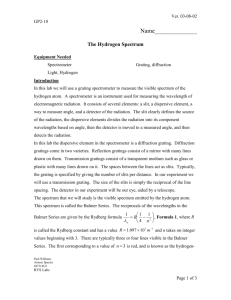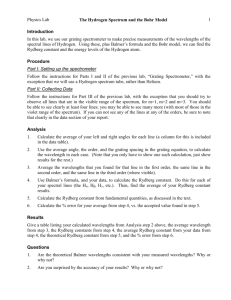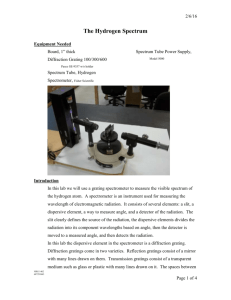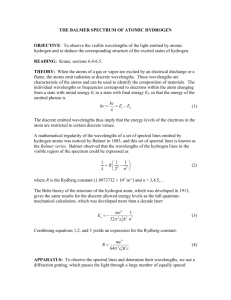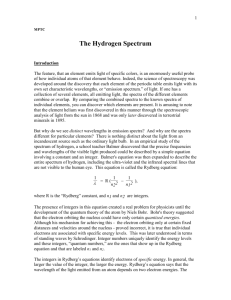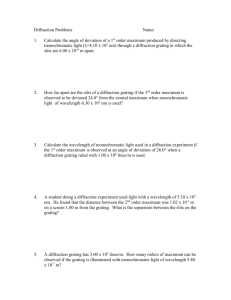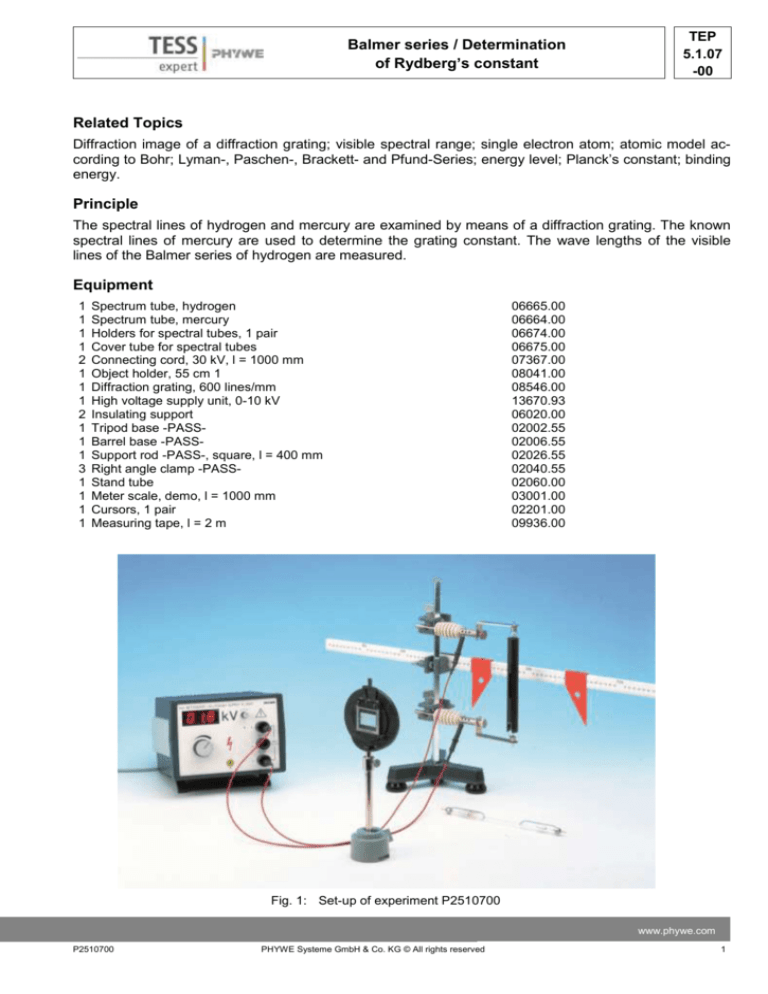
Balmer series / Determination
of Rydberg’s constant
TEP
5.1.07
-00
Related Topics
Diffraction image of a diffraction grating; visible spectral range; single electron atom; atomic model according to Bohr; Lyman-, Paschen-, Brackett- and Pfund-Series; energy level; Planck’s constant; binding
energy.
Principle
The spectral lines of hydrogen and mercury are examined by means of a diffraction grating. The known
spectral lines of mercury are used to determine the grating constant. The wave lengths of the visible
lines of the Balmer series of hydrogen are measured.
Equipment
1
1
1
1
2
1
1
1
2
1
1
1
3
1
1
1
1
Spectrum tube, hydrogen
Spectrum tube, mercury
Holders for spectral tubes, 1 pair
Cover tube for spectral tubes
Connecting cord, 30 kV, l = 1000 mm
Object holder, 55 cm 1
Diffraction grating, 600 lines/mm
High voltage supply unit, 0-10 kV
Insulating support
Tripod base -PASSBarrel base -PASSSupport rod -PASS-, square, l = 400 mm
Right angle clamp -PASSStand tube
Meter scale, demo, l = 1000 mm
Cursors, 1 pair
Measuring tape, l = 2 m
06665.00
06664.00
06674.00
06675.00
07367.00
08041.00
08546.00
13670.93
06020.00
02002.55
02006.55
02026.55
02040.55
02060.00
03001.00
02201.00
09936.00
Fig. 1: Set-up of experiment P2510700
www.phywe.com
P2510700
PHYWE Systeme GmbH & Co. KG © All rights reserved
1
TEP
5.1.0700
Balmer series / Determination
of Rydberg’s constant
Tasks
1. Determine the diffraction grating constant by means of the mercury spectrum.
2. Determine the visible lines of the Balmer series in the hydrogen spectrum, of Rydberg’s constant
and of the energy levels.
Set-up and Procedure
The experimental set-up is shown in Fig. 1. Hydrogen or mercury spectral tubes connected to the high
voltage power supply unit are used as a source of radiation. The power supply is adjusted to about 5 kV.
The scale is attached directly behind the spectral tube in order to minimize parallax errors. The diffraction grating should be set up at about 50 cm and at the same height as the spectral tube. The grating
must be aligned so as to be parallel to the scale. The luminous capillary tube is observed through the
grating (see Fig 2).
The room is darkened to the point where it is still
possible to read the scale. The distance 2 l between
Tab. 1: Determination of the grating constant from the
spectral lines of the same color in the right and left
wavelengths of the Hg spectrum
first order spectra are read through the grating. The
Color
λ / nm
2l / mm
g / µm
distance between the grating and the eye should be
so short, that both lines are visible at the same time
yellow
578.0
330
1.680
without moving the head. The distance d between
green
546.1
311
1.672
the scale and the grating is also measured.
blue
434.8
244
1.661
Three lines are clearly visible in the Hg spectrum.
The grating constant g is determined by means of
the wavelengths given in Table 1. Rydberg’s constant, and thus the energy levels in hydrogen, are
determined from the measured wavelengths by
means of Balmer’s formula.
Theory and evaluation
1. Diffraction grating
If light of wavelength l impinges on a grating with
constant g, it is diffracted. Intensity peaks occur
when the angle of diffraction α fulfills the following
condition:
𝑛 ∙ 𝜆 = 𝑔 ∙ sin 𝛼 ; 𝑛 = 0, 1, 2, …
(1)
Light is collected by the eye on the retina, therefore
the light source is seen in the color of the observed
spectral line on the scale in the prolongation of the
light beams. For the diffraction of the nth order, the
following relation is deduced from the geometrical
structure (Fig. 2):
𝑛∙𝜆 =𝑔∙
2
𝑙
√𝑑2 + 𝑙 2
Fig. 2: Diffraction at the grating.
(2)
PHYWE Systeme GmbH & Co. KG © All rights reserved
P2510700
TEP
5.1.07
-00
Balmer series / Determination
of Rydberg’s constant
In the examples given in Table 1, the average obtained for the three measurements of the grating constant is g = 1.671 mm.
2. Hydrogen spectrum
Due to collision ionization, H2 is converted to atomic hydrogen in the spectral tube. Electrons from the H
atoms are excited to higher energy levels through collisions with electrons. When they return to lower
energy levels, the atoms emit light of frequency f given by the energy difference of the concerned states:
𝐸 =ℎ∙f
(3)
where h is Planck’s constant.
Applying Bohr’s atomic model, the energy En of a permitted electron orbit is given by:
𝐸𝑛 = −
1 𝑒 4 𝑚𝑒
, 𝑛 = 1, 2, 3 …
8 𝜀02 ℎ2 𝑛2
(4)
where ε0 = 8.8542 · 10-34 As/Vm is the electric field constant, e = 1.6021 · 10-19 C is the electronic charge
and me = 9.1091 · 10-31 kg is the mass of the electron at rest. The emitted light can therefore have the
following frequencies:
𝑓𝑛𝑚
1 𝑒 4 𝑚𝑒 1
1
=
(
−
) , 𝑛, 𝑚 = 1, 2, 3 …
2
8 𝜀0 ℎ3 𝑛2 𝑚2
(5)
If the wave number N = l-1 is used instead of the frequency f, substituting c = l · f one obtains:
1
1
𝑁 = 𝑅𝑡ℎ ( 2 − 2 )
𝑛
𝑚
𝑤ℎ𝑒𝑟𝑒 𝑅𝑡ℎ =
(6)
1 𝑒 4 𝑚𝑒
= 1.097 ∙ 107 𝑚−1
8 𝜀02 ℎ3 𝑐
Here Rth is Rydberg’s constant, which follows from Bohr’s atomic model.
n = 1 : Lyman series
Spectral range: ultraviolet
n = 2 : Balmer series
Spectral range: ultraviolet till red
n = 3 : Paschen series
Spectral range: infrared
n = 4 : Bracket series
Spectral range: infrared
n = 5 : Pfund series
Spectral range: infrared
www.phywe.com
P2510700
PHYWE Systeme GmbH & Co. KG © All rights reserved
3
TEP
5.1.0700
Balmer series / Determination
of Rydberg’s constant
Fig. 3 shows the energy level diagram and the
spectral series of the H atom. For 𝑚 → ∞, one obtains the limits of the series; the associated energy is thus the ionization energy (or the binding
energy) for an electron in the nth permitted orbit.
The binding energy can be calculated by means
of the equation:
𝐸𝑛 = − 𝑅𝑡ℎ ∙ h ∙ c
1
n2
where c = 2.99795 · 108 m/s and h =
6.6256 · 10-34 J s = 4.13567 · 10-15 eV s. The
ground state is found to be 13.6 eV.
Tab. 2: Examples of measurements for the H spectrum
(Balmer series) Distance d = 450 mm
Line
2l
λexp
λlit
Rexp
Hα
384 mm
656 nm
656.28 nm
1.097 · 107 m-1
Hβ
275 mm
489 nm
486.13 nm
1.093 · 107 m-1
Hγ
243 mm
436 nm
434.05 nm
1.092 · 107 m-1
Hδ
–
–
410.17 nm
–
average: Rexp = 1.094 · 107 m-1
Note
-
-
-
If the room is sufficiently darkened, next to the
atomic hydrogen spectrum, the molecular H2
band spectrum may be observed. The numerous lines, which are very close to each other,
are due to the oscillations of the molecule.
The Hδ line is situated on the border of the visible spectral range and is too weak to be observed by simple methods.
The treatment of more complex atoms requires
quantum mechanics. In this case, the energies
of the states are determined by the eigenvalues
of the hamiltonian of the atom. For atoms similar to hydrogen, calculations yield the same results as Bohr’s atomic model.
Fig. 3: Energy level diagram of the H atom.
4
PHYWE Systeme GmbH & Co. KG © All rights reserved
P2510700

